Hantech WG100R ENZO Wireless Network Router User Manual Usermanual FCC
Hantech Corporation ENZO Wireless Network Router Usermanual FCC
Hantech >
Contents
- 1. users manual 1
- 2. users manual 2
users manual 2
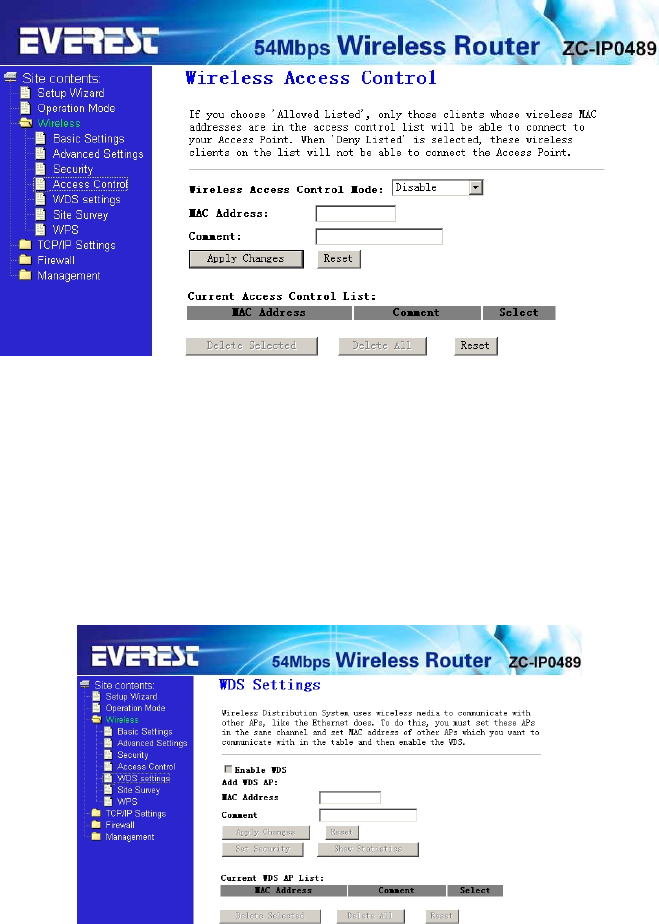
14
use an external authentication server (e.g., RADIUS) and EAP just like IEEE 802.1X is using or pre-
shared keys without need for additional servers. Wi-Fi calls these "WPA-Enterprise" and "WPA-
Personal", respectively. Both mechanisms will generate a master session key for the Authenticator (AP)
and Supplicant (client station).
802.1X: The original security mechanism of IEEE 802.11 standard was not designed to be strong and
has proven to be insufficient for most networks that require some kind of security. Task group I (Security)
of IEEE 802.11 working group has worked to address the flaws of the base standard and in practice
completed its work in May 2004. The IEEE 802.11i amendment to the IEEE 802.11 standard was
approved in June 2004 and published in July 2004.
WPA Cipher suite/WPA2 Cipher suite:The encryption piece of WPA and WPA2 mandates the use of
TKIP or, because it's considered to be more secure than TKIP, preferably AES encryption.
Pre-Shared Key Format: You can select PASSPHRASE or HEX(64 CHARACTERS).
Pre-Shared Key: You can input 128 characters key.
Authentication RADIUS Server:input Port and IP Address and Password.
4.2.4 Wireless Access Control
If you choose 'Allowed Listed', only those clients whose wireless MAC addresses are in the
access control list will be able to connect to your Access Point. When 'Deny Listed' is selected, these
wireless clients on the list will not be able to connect the Access Point.
4.2.5 WDS Settings
Wireless Distribution System uses wireless media to communicate with other APs, like the Ethernet does.
To do this, you must set these APs in the same channel and set MAC address of other APs which you
want to communicate with in the table and then enable the WDS
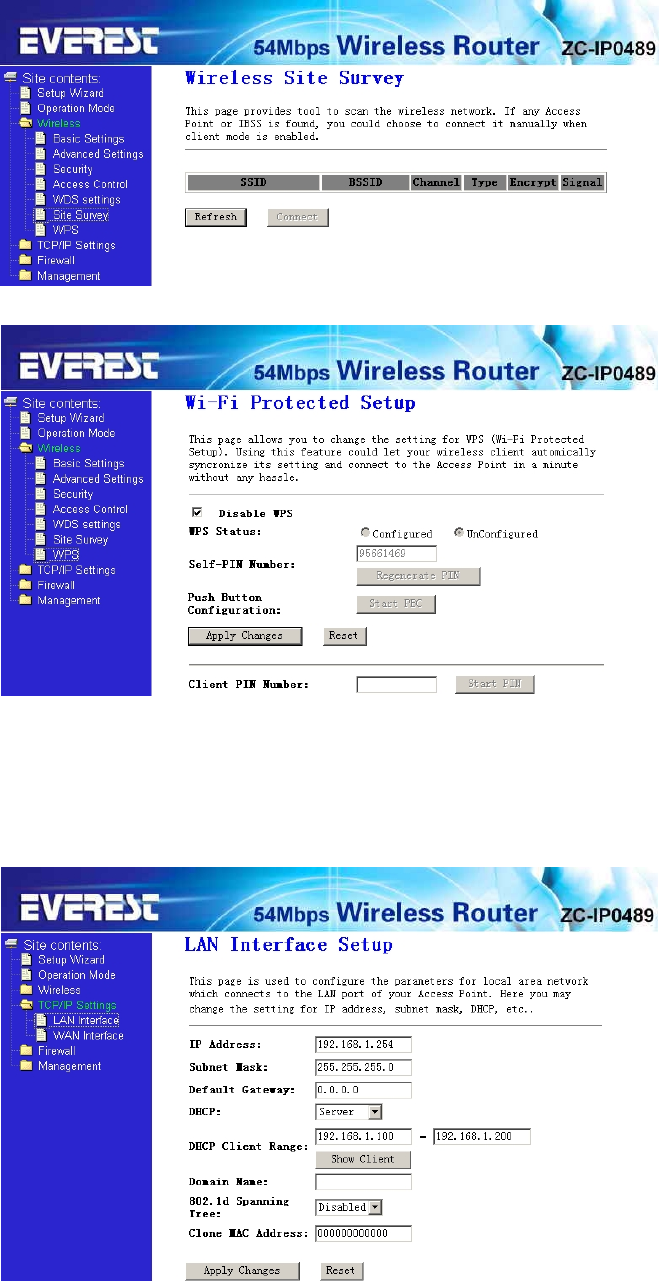
15
4.2.6 Wireless Site Survey
This page provides tool to scan the wireless network. If any Access Point or IBSS is found, you
could choose to connect it manually when client mode is enabled.
4.2.7 WPS Setting
This page allows you to change the setting for WPS (Wi-Fi Protected Setup). Using this feature
could let your wireless client automically syncronize its setting and connect to the Access Point in a
minute without any hassle.
4.3 TCP/IP Setting
4.3.1 LAN Setting Lan Interface setup
This page is used to configure the parameters for local area network which connects to the LAN
port of your Access Point. Here you may change the setting for IP addresss, subnet mask, DHCP, etc..
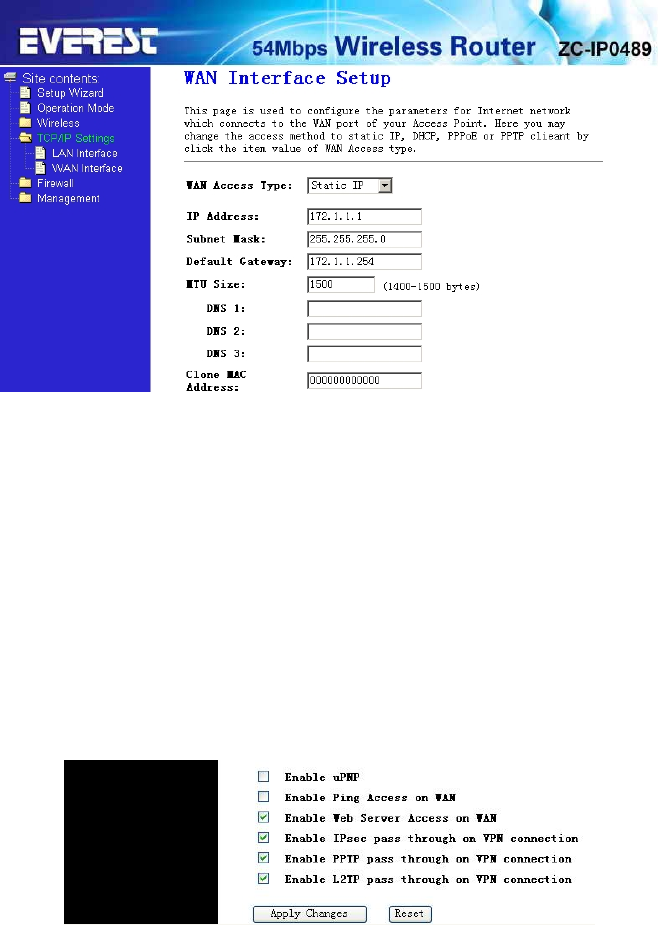
16
MAC Address - the physical address of the router, as seen from the LAN. The value can't be
changed.
IP Address - Enter the IP address of your router in dotted-decimal notation (factory default:
192.168.1.254).
Subnet Mask - An address code that determines the size of the network. Normally use 255.255.255.0
as the subnet mask.
DHCP: You can select None,Client,Serve. The router is set up by default as a DHCP (Dynamic Host
Configuration Protocol) server, which provides the TCP/IP configuration for all the PCs that are
connected to the router on the LAN.
DHCP Client Range: This field specifies the first of the addresses in the IP address pool.
802.1d Spanning Tree: The IEEE 802.1D Spanning Tree Algorithm (STA) ,loop prevention and redundant
link configuration. You can select disable or enable.if your mode was set WDS or AP+WDS, this item
should be set “enable”
Clone MAC Address:you can enter a MAC,Then click clone.
4.3.2WAN Interface
This page is used to configure the parameters for Internet network which connects to the WAN
port of your Access Point. Here you may change the access method to static IP, DHCP, PPPoE or PPTP
by click the item value of WAN Access type.
WAN Access Type,User name, password, Service: you can refer to 3.2 Quick Installation Guide.
Connection Type:you can select continous o, connect on demand, manual.
Idle time: when connection type is connect on demand,you can set idle time.
MTU Size: The normal MTU (Maximum Transmission Unit) value for most Ethernet networks is 1492
Bytes. For some ISPs you need to reduce the MTU. But this is rarely required, and should not be
done unless you are sure it is necessary for your ISP connection.
DNS:You can select Attain DNS Automatically or Set DNS Manually
Clone MAC Address: if you wang clone, input MAC Address
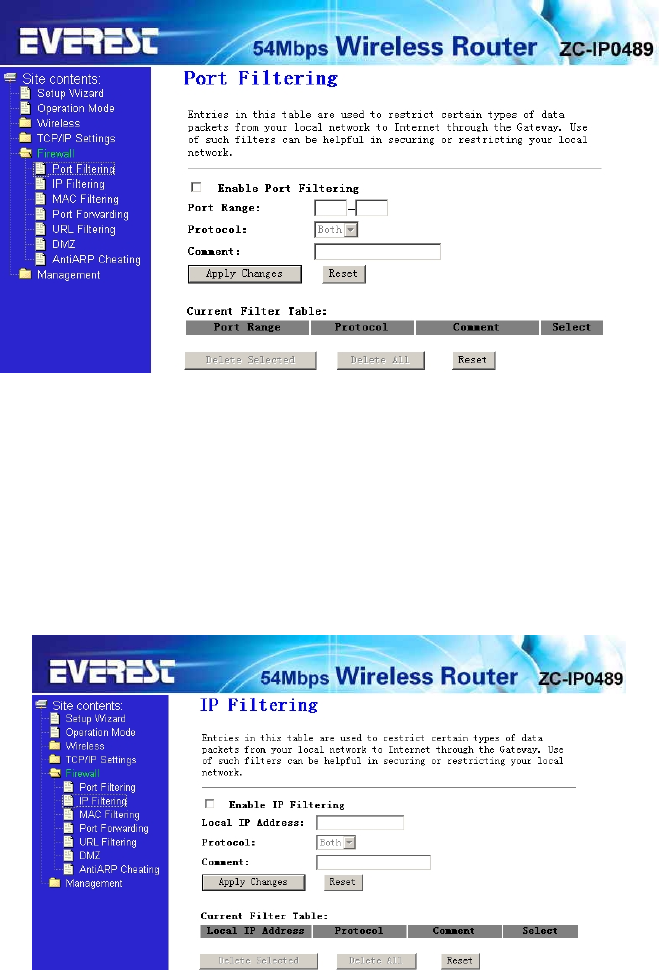
17
Enable UpnP: The Universal Plug and Play (UPnP) feature allows the devices, such as Internet
computers, to access the local host resources or devices as needed. UPnP devices can be automatically
discovered by the UPnP service application on the LAN.
Enable L2TP pass through on VPN connection:
Enable IPsec pass through on VPN connection:
Enable PPTP pass through on VPN connection:
4.4 Firewal
4.4.1 Port Filtering
Entries in this table are used to restrict certain types of data packets from your local network to Internet
through the Gateway. Use of such filters can be helpful in securing or restricting your local network.
Enable Port filtering: select it, you can modify port filter.
Port range: input the filter port, for eaample 20-220
Protocol: you can select both,TCP,UDP
Cuurrent filter table: The list of port filter.
4.4.2 IP Filtering
Entries in this table are used to restrict certain types of data packets from your local network to Internet
through the Gateway. Use of such filters can be helpful in securing or restricting your local network.
Enable IP Filtering: select it, you can modify IP filter.
Local IPAddress:input the IP Address,for example:192.168.1.23.
Protocol: you can select both,TCP,UDP
Cuurrent Filter table: The list of IP filter.
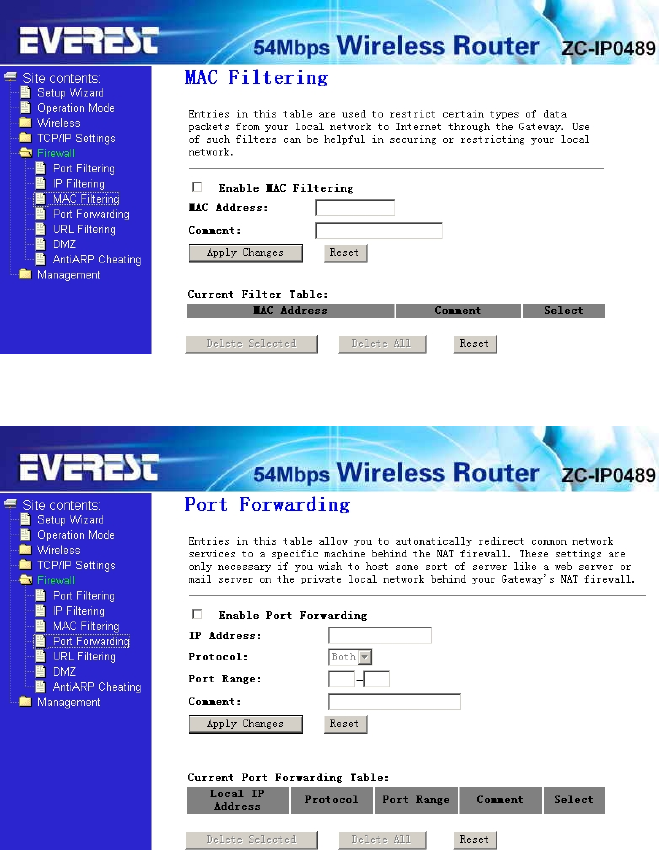
18
4.4.3 MAC Filtering
Entries in this table are used to restrict certain types of data packets from your local network to Internet
through the Gateway. Use of such filters can be helpful in securing or restricting your local network
Enable MAC Filtering: select it,you can modify MAC filter.
MACAddress:type the MACAddress,for
example:00:e0:4e:3f:2d:c5.
Cuurrent Filter table: The list of MAC filter.
4.4.4 Port Forwarding
Entries in this table allow you to automatically redirect common network services to a specific machine
behind the NAT firewall. These settings are only necessary if you wish to host some sort of server like a
web server or mail server on the private local network behind your Gateway's NAT firewall.
Enable MAC Address:select it,you can modify MAC Address Filtering..
IP Address: The IP Address of the PC running the service application
Protocol - The protocol used for this application, either TCP, UDP, or both (all protocols supported
by the router).
Port Range- The numbers of External Ports. You can type a service port or a range of service
ports (the format is XXX – YYY, XXX is Start port, YYY is End port).
Current Port Forward Table: port forward services already list.
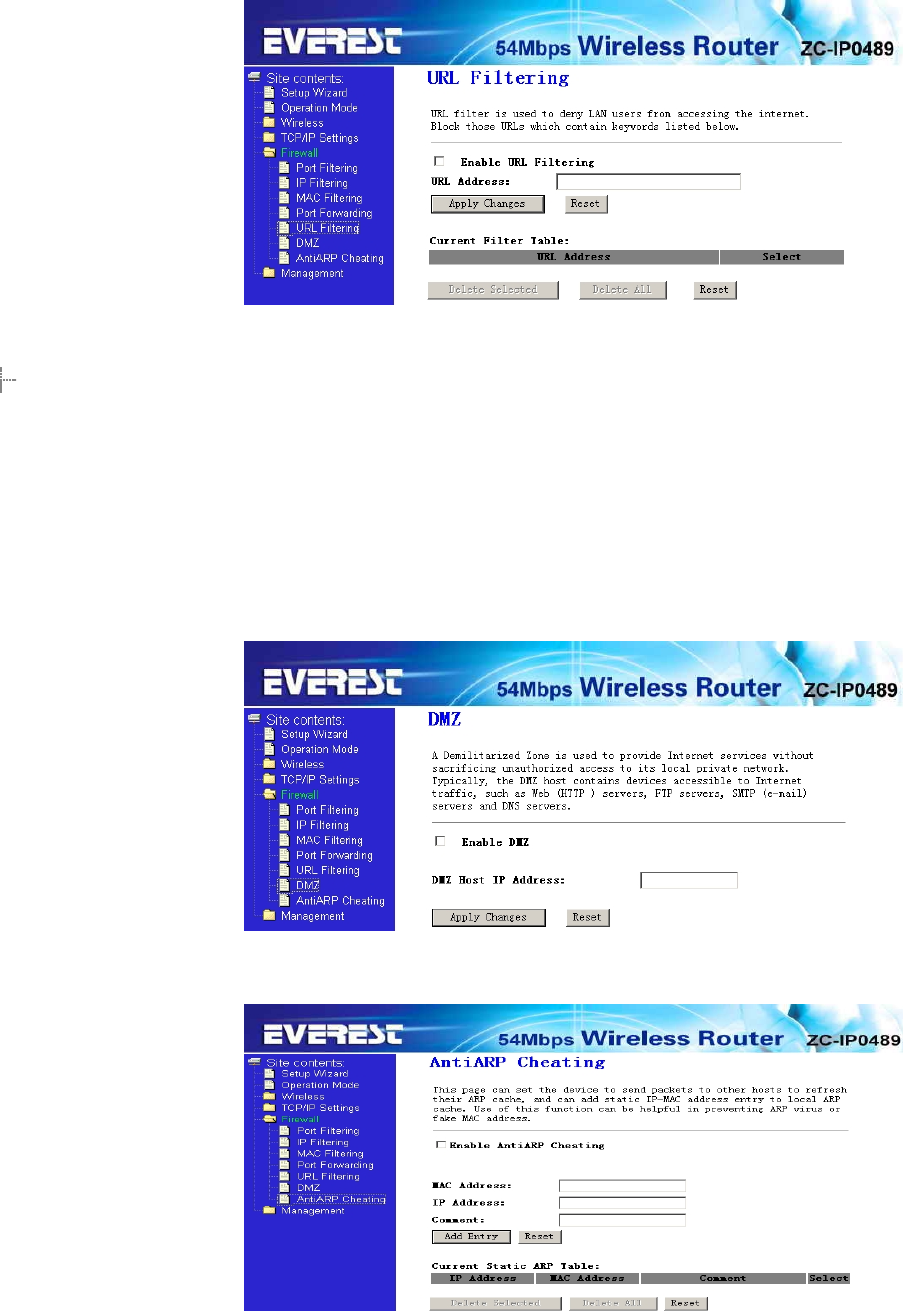
19
4.4.5 URL Filtering
URL filter is used to deny LAN users from accessing the internet. Block those URLs which contain
keywords listed below.
Enable URL : select it, you can edit URL, For example:xxx.com
Click apply changes.
4.4.6 DMZ
The DMZ host feature allows one local host to be exposed to the Internet for a special-
purpose service such as Internet gaming or videoconferencing. DMZ host forwards all the ports
at the same time. Any PC whose port is being forwarded must have its DHCP client function disabled
and should have a new static IP Address assigned to it because its IP Address may change when using
the DHCP function.
DMZ Enable: Select it, DMZ can be edit..
DMZ Host IP Address:input IP Address.for example 192.168.1.34.
Click apply changes,complete set DMZ.
4.4.7 AntiARP Cheating
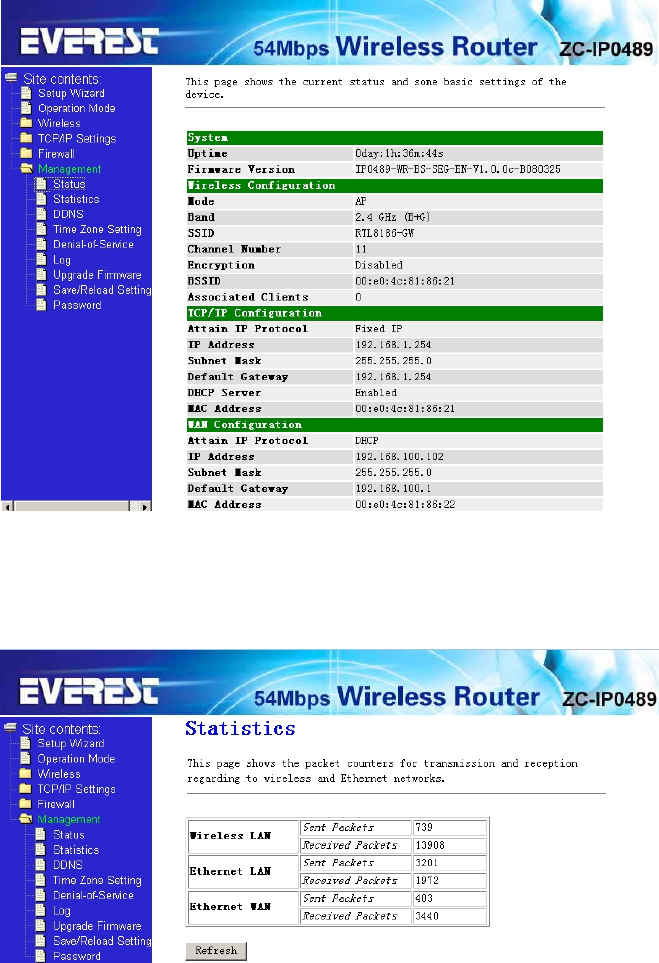
20
This page can set the device to send packets to other hosts to refresh their ARP cache, and can add static
IP-MAC address entry to local ARP cache. Use of this function can be helpful in preventing ARP virus or
fake MAC address
4.5 Management
4.5.1 Status
This page shows the current status and some basic settings of the device. you can check system
Information, LAN Interface Information, WAN Interface Information.
4.5.2 Statistics
This page shows the packet counters for transmission and reception regarding to wireless and
Ethernet networks.
4.5.3 Dynamic DNS Setting
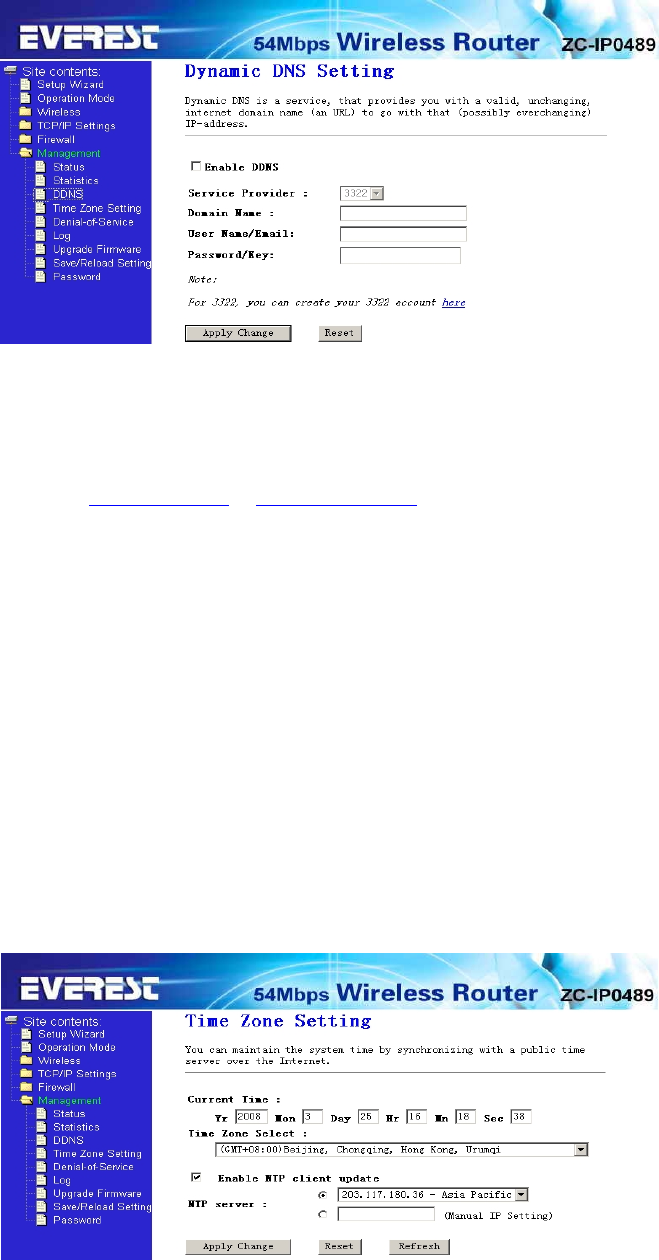
21
Dynamic DNS is a service, that provides you with a valid, unchanging, internet domain name (an
URL) to go with that (possibly everchanging) IP-address. DDNS lets you assign a fixed host and
domain name to a dynamic Internet IP Address. It is useful when you are hosting your own website,
FTP server, or other server behind the router. Before using this feature, you need to sign up for DDNS
service providers such as www.oray.net or www.comexe.cn. The Dynamic DNS client service provider
will give you a password or key.
To set up for DDNS, follow these instructions:
1. Type your dervice provider.
2. Type the User Name for your DDNS account.
3. Type the Password for your DDNS account.
4. Domain Name - the domain names are displayed here. Click Apply Changes to logout the DDNS
service.
4.5.4 Time Zone Setting
You can maintain the system time by synchronizing with a public time server over the Internet.
Current time: type the date and time.
Time Zone Select: Select your local time zone from this pull down list.
Enable NTP client update:select it, you can get the time from NTP.
NTP server :select a server from list.
Click the Apply changes get the time from Internet if you have connected to
Internet.
4.5. 5 Denial of Service
A "denial-of-service" (DoS) attack is characterized by an explicit attempt by hackers to prevent legitimate
users of a service from using that service.
Enable DOS Prevention:select it, you can modify DOS Prevention.
Enable Source IP Blocking: you can input source IP Blocking time
Click apply changes,DOS take effect.
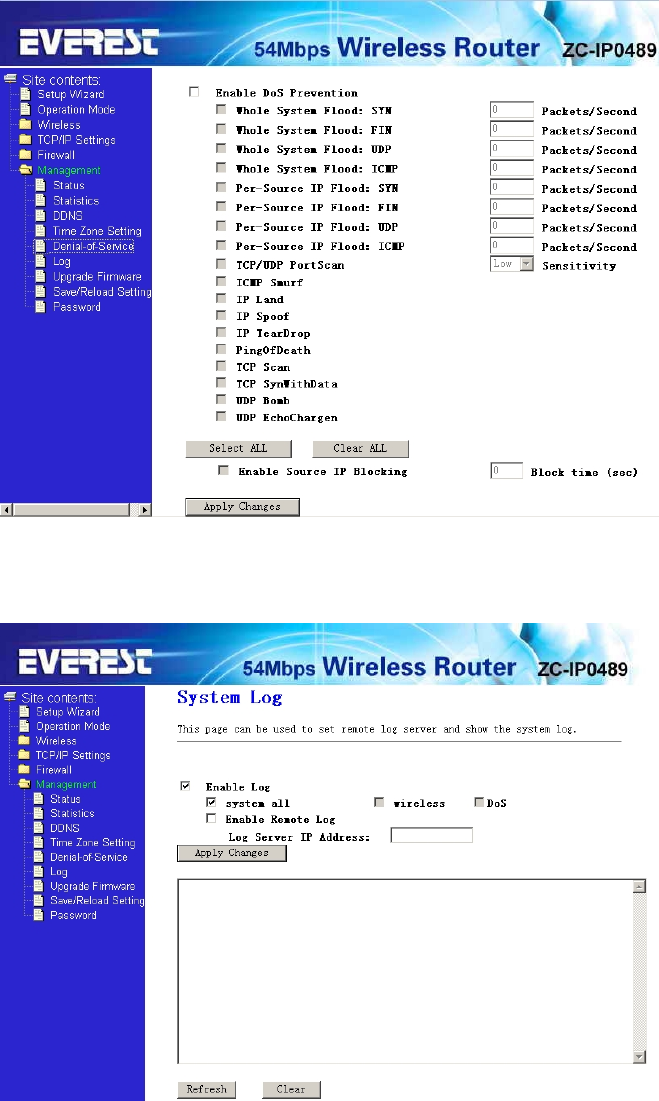
22
4.5.6 Log
This page can be used to set remote log server and show the system log.
4.5.7 Upgrade Firmware
This page allows you upgrade the Access Point firmware to new version. Please note, do not power off
the device during the upload because it may crash the system
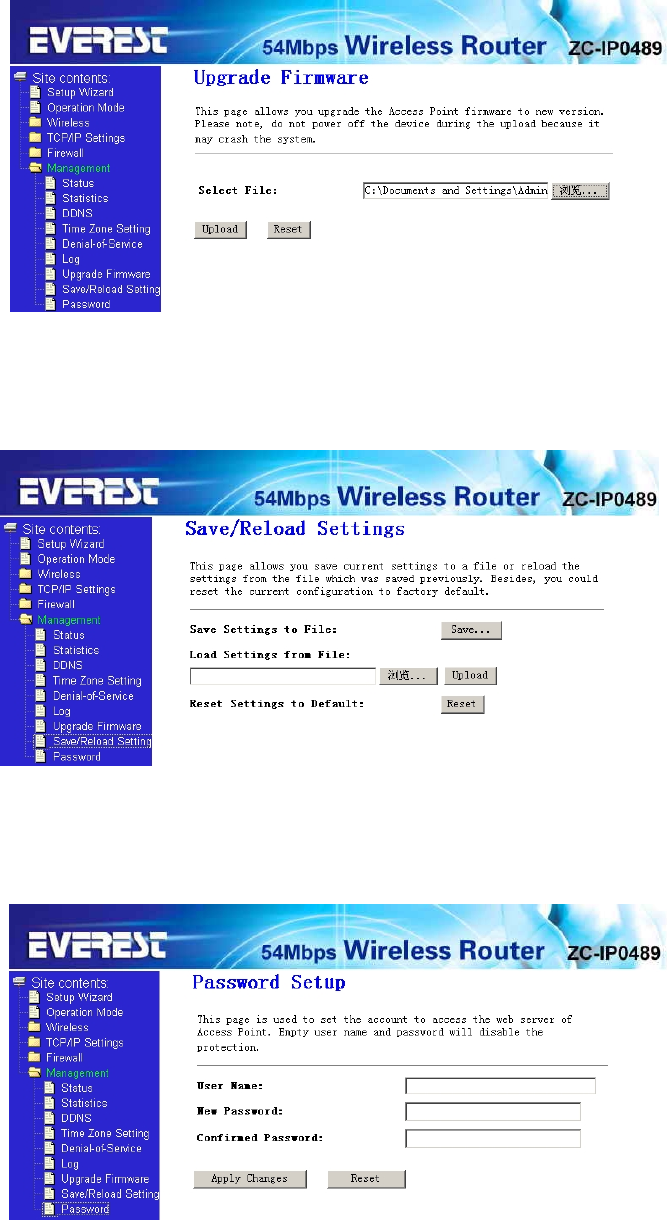
23
4.5.8 Save/Reload settings
This page allows you save current settings to a file or reload the settings from the file which was saved
previously. Besides, you could reset the current configuration to factory default.
4.5.9 Password setup
This page is used to set the account to access the web server of Access Point. Empty user name and
password will disable the protection.
Appendix
1:
FAQ
1. How do I configure the router to access Internet by ADSL users?
1) First, configure the ADSL modem configured in RFC1483 bridge model.
2) Connect the Ethernet cable from your ADSL modem to the WAN port on the router. The
telephone cord plugs into the Line port of the ADSL modem.
3) Login to the router, click the “TCP/IP settings” menu on the left of your browser, and click

24
"WAN Interface" submenu. On the WAN page, select “PPPoE” for WAN Connection Type.
Type user name in the “User Name” field and password in the “Password” field, finish by
clicking “Connect”.
4) If your ADSL lease is in “pay-according-time” mode, select “Connect on Demand” or
“Manual” for Internet connection mode. Type an appropriate number for Time to avoid
wasting paid time. Otherwise, you can select “continous” for Internet connection mode.
2. How do I configure the router to access Internet by Ethernet users?
1) Login to the router, click the “TCP/IP Settings” menu on the left of your browser, and click
"LAN Interface" submenu. On the WAN page, select “DHCP” for "Client", finish by clicking
“apply changes”.
2) Some ISPs require that you register the MAC Address of your adapter, which is connected to
your cable or DSL modem during installation. If your ISP requires MAC register, login to the router
and click the "TCP/IP Setting" menu link on the left of your browser, and then click "LAN Interface",
if your PC’s MAC address is proper MAC address,type your PC’s MAC address will fill in the
"Clone MAC Address" field. Or else,The format for the MAC Address is XX-XX-XX-XX-XX-XX.
Then click the "apply changes" button. It will take effect after rebooting.
3.I want to use Netmeeting, what do I need to do?
1) If you start Netmeeting as a sponsor, you don’t need to do anything with the router.
2) If you start as a responsor, you need configure Virtual Server or DMZ Host.
3) How to configure Virtual Server: Login to the router, click the “Forwarding” menu on the left of your
browser, and click " port foward" submenu. On the "port forward " page, enter “1720” into the blank
below the “Service Port”, and your IP address below the IP Address, assuming
192.168.1.25469 for an example, remember to “supply changes”.
4) How to enable DMZ Host: Login to the router, click the “firewall settings” menu on the left of
your browser, and click " DMZ" submenu. On the "DMZ" page, click “Enable DMZ” radio and type
your IP address into the “DMZ Host IP Address” field, using 192.168.1.25469 as an example,
remember to click the "Apply changes” button.
4. The wireless stations cannot connect to the router.
1) Make sure the "Disable Wireless LAN Interface " is not select.
2) Make sure that the wireless stations' SSID accord with the router's SSID.
3) Make sure the wireless stations have right KEY for encryption when the router is encrypted.
4) If the wireless connection is ready, but you can’t access the router, check the IP Address of your
wireless stations.
Appendix
2:
Specifications
General
Standards IEEE 802.3, 802.3u, 802.11b and 802.11g
Protocols TCP/IP, PPPoE, DHCP, ICMP, NAT, SNTP
Ports One 10/100M Auto-Negotiation WAN
RJ45 port, Four 10/100M Auto-
Cabling Type 10BASE-T: UTP category 3, 4, 5
cable (maximum 100m)
EIA/TIA-568 100
Ω
STP
(
maximum 100m
)
Radio Data Rate 54/48/36/24/18/12/9/6/11/5.5/3/2/1Mbps
Power Supply 9V~ 800mA

25
LEDs Power, M1, WLAN, 1,2,3,4
Environmental and Physical
Operating Temp. 0~40 ℃℃ (32 ~104 )℉℉
Operating Humidity 10% - 95% RH, Non-condensing
Dimensions (W×D×
H)
7.9×4.7×1.2 in. (201×120×31.10 mm)
Appendix
3:
Glossary
802.11b - The 802.11b standard specifies a wireless networking at 11 Mbps using direct-sequence
spread-spectrum (DSSS) technology and operating in the unlicensed radio
spectrum at 2.4GHz, and WEP encryption for security. 802.11b networks are also referred to as
Wi-Fi networks.
802.11g - specification for wireless networking at 54 Mbps using direct-sequence spread-spectrum
(DSSS) technology, using OFDM modulation and operating in the unlicensed radio spectrum at
2.4GHz, and backward compatibility with IEEE 802.11b devices, and WEP encryption for security.
DDNS (Dynamic Domain Name System) - The capability of assigning a fixed host and domain name to
a dynamic Internet IP Address.
DHCP (Dynamic Host Configuration Protocol) - A protocol that automatically configure the
TCP/IP parameters for the all the PCs that are connected to a DHCP server.
DMZ (Demilitarized Zone) - A Demilitarized Zone allows one local host to be exposed to the Internet for
a special-purpose service such anternet gaming or videoconferencing.
DNS (Domain Name Server) - An Internet Service that translates the names of websites into IP
addresses.
Domain Name - A descriptive name for an address or group of addresses on the Internet.
DoS (Denial of Service) - A hacker attack designed to prevent your computer or network from
operating or communicating.
DSL (Digital Subscriber Line) - A technology that allows data to be sent or received over existing
traditional phone lines.
ISP (Internet Service Provider) - A company that provides access to the Internet
MTU (Maximum Transmission Unit) - The size in bytes of the largest packet that can be transmitted.
NAT (Network Address Translation) - NAT technology translates IP addresses of a
local area network to a different IP address for the Internet.
PPPoE (Point to Point Protocol over Ethernet) - PPPoE is a protocol for connecting remote hosts to
the Internet over an always-on connection by simulating a dial-up connection.
SSID - A Service Set Identification is a thirty-two character (maximum) alphanumeric key identifying a
wireless local area network. For the wireless devices in a network to communicate with each other,
all devices must be configured with the same SSID. This
is typically the configuration parameter for a wireless PC card. It corresponds to the
ESSID in the wireless Access Point and to the wireless network name.
WEP (Wired Equivalent Privacy) - A data privacy mechanism based on a 64-bit or
26
128-bit or 152-bit shared key algorithm, as described in the IEEE 802.11 standard.
Wi-Fi - A trade name for the 802.11b wireless networking standard, given by the Wireless Ethernet
Compatibility Alliance (WECA, see http://www.wi-fi.net), an industry standards group promoting
interoperability among 802.11b devices.
WLAN (Wireless Local Area Network) - A group of computers and associated devices
communicate with each other wirelessly, which network serving users are limited in a local area.
Federal Communication Commission Interference Statement
This equipment has been tested and found to comply with the limits for a Class B digital device, pursuant
to Part 15 of the FCC Rules. These limits are designed to provide reasonable protection against harmful
interference in a residential installation. This equipment generates, uses and can radiate radio frequency
energy and, if not installed and used in accordance with the instructions, may cause harmful interference
to radio communications. However, there is no guarantee that interference will not occur in a particular
installation. If this equipment does cause harmful interference to radio or television reception, which can
be determined by turning the equipment off and on, the user is encouraged to try to correct the
interference by one of the following measures:
- Reorient or relocate the receiving antenna.
- Increase the separation between the equipment and receiver.
- Connect the equipment into an outlet on a circuit different from that to which the receiver is connected.
- Consult the dealer or an experienced radio/TV technician for help.
This device complies with Part 15 of the FCC Rules. Operation is subject to the following two conditions:
(1) This device may not cause harmful interference, and
(2) this device must accept any interference received, including interference that may cause undesired
operation.
FCC Caution:
Any changes or modifications not expressly approved by the party responsible for compliance could void
the user's authority to operate this equipment.
IMPORTANT NOTE:
FCC Radiation Exposure Statement: This equipment complies with FCC radiation exposure limits set forth
for an uncontrolled environment. This equipment should be installed and operated with minimum distance
20cm between the radiator & your body. This transmitter must not be co-located or operating in
conjunction with any other antenna or transmitter.